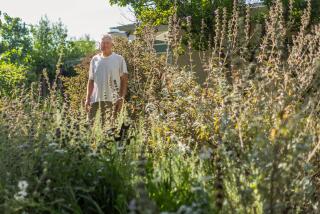Fungus Attacks Trunks of Grapefruit
- Share via
QUESTION: My mature grapefruit developed splits in the bark, and sap drips out. It affects one limb at a time, and sometimes a branch will die almost overnight. Is it a fungus? And what is this new oleander blight we’re seeing in the desert?
--K.S., Palm Desert
ANSWER: The dripping grapefruit probably has brown rot gummosis, which is a fungus that attacks the trunk and may spread to branches and roots. The University of California suggests keeping the trunk and branches dry, preventing sprinklers from hitting the bark.
You can scrape away the infected bark with a sharp knife, along with a little additional healthy bark around the edges. Allow the area to dry and repeat if it reoccurs.
The other problem you mention, called bacterial leaf scorch, is affecting oleanders in Orange and Riverside counties, especially in the Palm Springs area. It is a bacteria--that much is known--and university experts think it is transmitted by a kind of leafhopper. As yet there are no controls, and it’s still a bit of a mystery disease. The only suggestions are to keep plants as healthy as can be.
University researchers are evaluating potential replacements for oleanders that are killed but as yet have no suggestions.
Skunks Won’t Climb Even a Short Fence
Q: My garden near the edge of Eaton Canyon labors under many disadvantages, including oak root fungus and Irish wolfhounds. The final straw this summer is that skunks dig up the perennials and annuals in my front border in search of grubs and other comestibles. My neighbors have suggested several solutions, but do you have any advice?
--T.J., Altadena
A: The only proven deterrent I’ve heard about is a fence. Apparently skunks are poor climbers and a simple 2-foot-tall wire fence will keep them out. The idea your neighbor suggested--weaving old climbing rose canes through the beds--sounds promising. It’s too bad you have no climbing roses. One neighbor also suggested mothballs, but I wouldn’t suggest putting them in the garden, and they wouldn’t be effective for long anyway. Perhaps other skunk-plagued readers have some ideas?
Direct Seeding Works for Certain Plants
Q: In one of your columns you suggest starting seeds in flats, then moving them to larger containers before planting. Can’t I start seeds right in the ground?
--S.S., Granada Hills
A: Most certainly. Some plants are best started from seed sowed in the ground. In fact, a case could be made that all plants grow stronger when sown where they are to grow, even huge trees, which is the theory behind a method of reforestation called “direct seeding.”
Unhampered by a pot, the tap root quickly goes deep in search of water, firmly anchoring the tree. Few direct-sown trees fall down in windy weather. I’ve grown tall eucalyptus from seed sown where they are to grow, and they quickly outgrow those planted from containers and end up being much sturdier trees.
However, for practical reasons, it’s often easier to first start seed in containers. If you have a small garden (as I do), you can begin one crop before the other is finished, before there is room in the garden. For instance, right now I have some winter vegetables waiting in their small containers while a few summer stragglers are finishing up.
If you are plagued by slugs or snails, starting seeds in containers keeps seedlings up out of harm’s way. Many people complain that their seed didn’t germinate when, in fact, seedlings were simply munched overnight.
You can give the seeds a better soil in a flat or other container, they are easier to keep watered and you can modify the environment by moving the container to a warmer or cooler place or give it more or less shade.
Most flowers transplant easily, but some grow so readily from seed sown in the ground that transplanting makes little sense. At this time of the year, sweet alyssum, red flax, crimson Flanders poppy and larkspur are several that are best sown in the ground. In summer, you’ll find marigolds, nasturtiums, nicotiana and zinnias especially easy.
California wildflowers, which you can plant in October and November, are best sown directly in the ground, though you must protect the seed with bird netting propped up on short twigs or stakes (remove after seedlings are several inches tall). Few transplant well and plants bought at a nursery are usually a disappointment.
Some vegetables must be started in the ground because they transplant poorly--carrots and beets for instance. Cucumbers hate transplanting, so they should always be sown directly in the ground. On the other hand, broccoli and cauliflower tend to lean if they are not transplanted, placed a little deeper than they were in the pot.
Sowing in the ground, or in containers, really depends on the particular plant and situation.
Protect Avocados From Marauding Squirrels
Q. Squirrels are harvesting my avocados before I can get to them. Is there a way to thwart them?
--S.L., Pasadena
A. Ben Faber, the avocado specialist with the Ventura County UC Cooperative Extension had some interesting things to say about squirrels.
He said that rats, particularly roof rats, are a bigger problem but that some commercial growers have had to deal with squirrels too. Squirrels, he said, actually have the smarts to cut avocados and let them fall to the ground to ripen, after first taking a sample bite to see if they are ripe enough for harvesting. As all gardeners should know, avocados won’t ripen on the tree.
In my own garden, I let the squirrels sample and then cut the avocados loose. I pick the fruit up off the ground and let them finish ripening. I simply cut around the holes they nibble.
To control the squirrels, Faber suggested making a collar of 2-foot-wide metal flashing that you wrap around the trunk 6 feet off the ground. This keeps squirrels from climbing the tree. However, if there are other trees or a building nearby, this won’t work because squirrels can leap 15 feet through the air.
You could also try live trapping, but squirrels are protected in many communities so check with animal control officers to see if this is allowed. Sticky peanut butter is a good bait and Faber suggests baiting the trap for a few days with the doors locked open so the squirrels get used to it before actually setting the trap.
Commercial growers have found that Jack Russell terriers will chase squirrels off, if the bushy-tailed beasts ever come down to the ground. Cats are best on roof rats.
Get Right Variety of Zoysia Grass
Q. I have been noticing that several magazines have ads for amazing varieties of zoysia grass from a nursery in Maryland. Before I buy I would like to know if this grass is like it is advertised to be.
--T.M., Pomona
A. Most of these miraculous varieties of zoysia are ‘Meyer’ varieties (though the ads may use other, fanciful names) and they do poorly in Southern California. They have a very long dormant season--when they are completely brown--and are slow to become established.
If you want to plant a zoysia, look for sod or plugs or a variety developed here named ‘El Toro.’ Many nurseries can order it for you. This variety is very fast to fill in and has much better color and texture, plus a short dormant season. In coastal areas it might not even go dormant.
*
Questions should be sent to “Garden Q&A;” in care of the Real Estate section, Los Angeles Times, Times Mirror Square, Los Angeles, CA 90053. Please include your address and telephone number. Questions cannot be answered individually.






